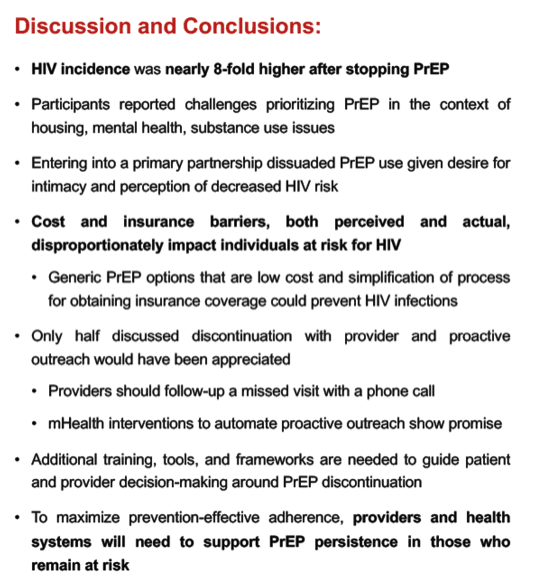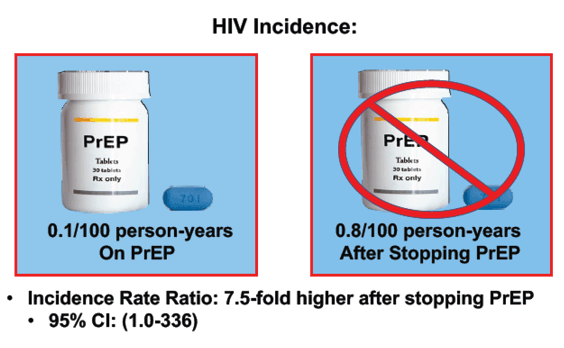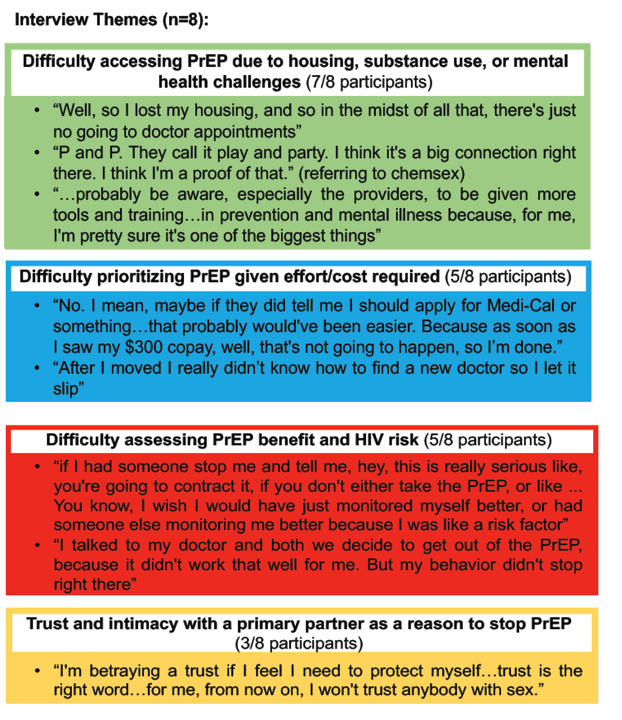 |
 |
 |
| |
HIV Infection Rate Jumps 7.5-fold When US PrEP Users Stop
|
| |
| |
Download the PDF here
10th IAS Conference on HIV Science (IAS 2019), July 21-24, 2019, Mexico City
Mark Mascolini
HIV diagnoses jumped 7.5-fold after at-risk people stopped preexposure prophylaxis (PrEP) in a San Francisco group that started PrEP between 2012 and 2018 [1]. Difficulty accessing PrEP because of housing, substance use, or mental health challenges emerged as a frequent reason for quitting PrEP.
Many studies confirm the effectiveness of PrEP in preventing HIV infection in diverse at-risk populations. But studies in real-world cohorts show that fewer than half of PrEP starters in US groups continue PrEP for 1 year. Because little is known about HIV infection risk or HIV acquisition in people who stop PrEP, researchers at the University of California, San Francisco (UCSF) and other centers conducted this study.
The investigators identified people who started PrEP at 1 of 15 clinics for publicly insured or uninsured people from July 2012 through November 2018. They pinpointed PrEP start and stop times through PrEP navigator records or detailed chart review, and they used the CDC's Enhanced HIV/AIDS Reporting System to identify HIV seroconversions (new infections).
The 986 people who started PrEP had a median age of 35, 66% were men who have sex with men (MSM), and 12% were transwomen. The racially diverse population included 37% whites, 25% Latinx, 13% black, 8% Asian, and 18% mixed or other groups. Eight people became infected with HIV during the study period, 7 after stopping PrEP and 1 while using as-needed PrEP incorrectly and counted as being on PrEP. Newly infected people included 5 MSM, 3 transwomen, 3 whites, 2 blacks, 2 Latinx, and 1 Native American. Four of these 8 did not discuss stopping PrEP with their provider. Person-time on PrEP was 953 person-years and after stopping PrEP 895 person-years.
HIV incidence (the new-infection rate) measured 0.1 per 100 person-years on PrEP and 0.8 per 100 person-years after stopping PrEP. Those numbers yielded a 7.5-fold higher HIV incidence after stopping PrEP (95% confidence interval 1.0 to 336).
In-depth interviews revealed several challenges to continuing PrEP:
-- 7 of 8 people: difficulty accessing PrEP because of housing, substance use, or mental health problems
-- 5 of 8 people: difficulty prioritizing PrEP because of cost or effort required
-- 5 of 8 people: difficulty assessing PrEP benefit versus HIV risk
-- 3 of 8 people: stopped PrEP because of trust and intimacy with a new primary partner
The researchers proposed that "cost and insurance barriers, both perceived and actual, disproportionately impact individuals at risk for HIV." They suggested that low-cost generic PrEP options and a simpler route to insurance coverage "could prevent HIV infections." Because only half of these newly infected people discussed stopping PrEP with their provider, the investigators urged providers to follow up by phone when PrEP users miss a visit.
Reference
1. Spinelli MA, Scott H, Laborde N, et al. HIV infection after stopping PrEP in a U.S. safety-net integrated health system: A mixed methods study. 10th IAS Conference on HIV Science (IAS 2019), July 21-24, 2019, Mexico City. Abstract TUPEC428. For e-poster: https://programme.ias2019.org//PAGMaterial/eposters/1769.pdf



|
| |
|
 |
 |
|
|